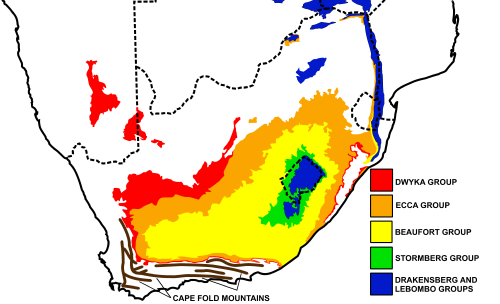Skull
The skull of Herpetoskylax is noted to have been preserved unusually well in regards to other biarmosuchians. It is approximately 13 centimeters long. [2] Skull sutures can be recognized and the skull itself is only compressed slightly. [2] It displays primitive features such as a convex curve to the skull roof when viewed from the side, a "deep snout," [2] a small temporal opening, and the absence of a freestanding coronoid process on the lower jaw. It has large eyes, a trait shared with other biarmosuchians. It is inferred that the premaxilla was short, similar to its fellow biarmosuchian, Lycaenodon . [2]
Four premaxillary teeth are present with few serrations (likely from attrition), but it is suggested there was an additional tooth based on a gap noted in the region. The genus has no precanine maxillary teeth, but it does have significant canines. Serrations are present on the posterior side of said canines, as well as on the postcanine teeth. [2]
The skull differs from other biarmosuchians in the configuration of the septomaxilla, of which both sides were preserved. The septomaxilla, a small bone associated with the nose area, [5] goes in between the maxilla and the external naris (nose). The maxilla is a smooth, sizable bone. The relation between the premaxilla and maxilla is unknown due to insufficient preservation. [2] The postfrontal bone, dorsal to the eyes, is flat, [2] particularly in contrast with this specimen's relatives, which often have display structures in this region. [6] Sidor and Rubidge comment that the morphology of Herpetoskylax's jugal (cheek bone) is easiest to see compared to other biarmosuchians. [2]
Across non-mammal therapsids, of which Herpetoskylax is part of, in terms of the braincase, the inside shape of the skull is generally primitive. [7] They have no enlargement of their cerebral hemisphere or their cerebellum, no divide between cerebral hemispheres, and they may have had small olfactory bulbs. However, biarmosuchians have more derived features as well, such as a strong flexure at the level of the midbrain. [7]
Palate
Herpetoskylax lacks palatal dentition, which is a feature seen in many tetrapods. [8] It has been theorized that the loss of palatal teeth in more derived tetrapods was perhaps due to changes in feeding or the expansion of the secondary palate, but it cannot be confirmed. [8]
There is compression in the palate so its finer details are unknown, such as whether the vomer is connected to the palatine or pterygoid. [2]
Lower Jaw
In the holotype, the left side of the back lower jaw is missing, but the right side was preserved well. The lower jaw is fairly narrow. Anteriorly, the jaw is shallow, but posteriorly it deepens, which is characteristic of biarmosuchians. [2]



